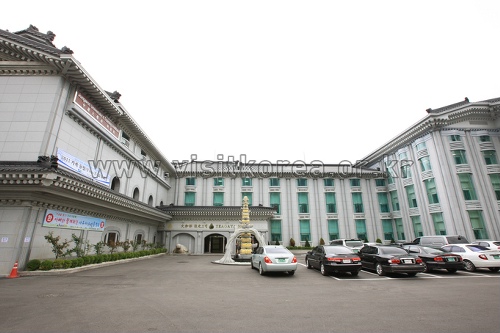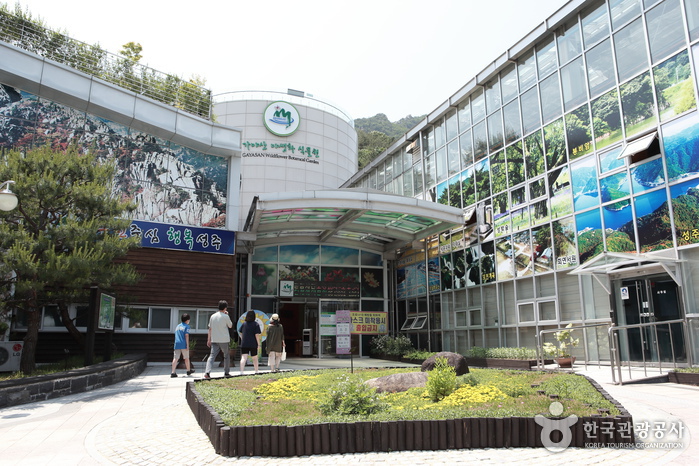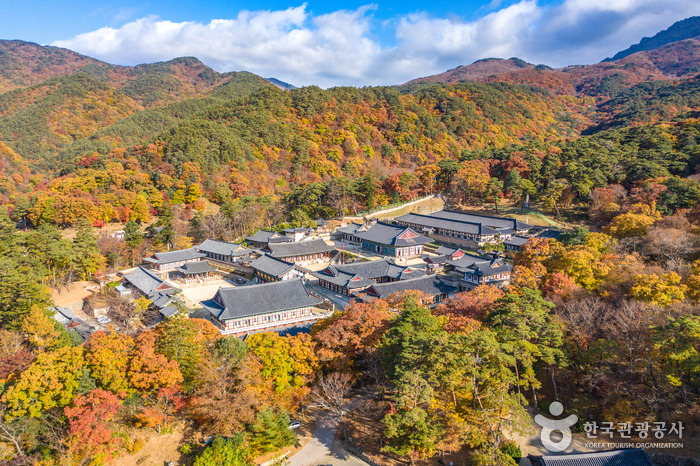Nonggamatjip Mil (농가맛집 밀)
13.3 Km 4139 2024-02-23
1566 Deogun-ro, Suryun-myeon, Seongju-gun, Gyeongsangbuk-do
054-931-2660
Nonggamatjip Mil is located near Gayasan Wildflower Botanical Garden. This establishment serves dishes made from vegetables harvested from Gayasan Mountain, in-house produced honey, and agricultural products from Seongju. Their signature offering is the Mil hanjeongsik (Korean table d'hote), featuring borigulbi (barley-aged dried yellow croaker), grilled chicken, and japchae. Additionally, they offer handmade bowls, honey, and flower tea for sale.
Gayasan National Park (Baegundong Area) (가야산국립공원-백운동 지구)
13.7 Km 19960 2021-04-28
Baegun-ri, Seongju-gun, Gyeongsangbuk-do
+82-55-930-8000
Gayasan Mountain in Gyeongsangbuk-do was designated as a national park in 1972. The mountain's main peak, Chilbulbong Peak, towers at 1,433 meters. It borders Seongju-gun, Hapcheon-gun and Geochang-gun. In particular, the mountain range stretching along Suryun-myeon, Seongju-gun is famous for its scenic nature. Furthermore, the beautiful Gayasan Beltway, which extends from Suryun-myeon to Gayasan Mountain, highlights the splendor and grandeur of the precipitous crimson cliffs.
Gaya Hotel (가야호텔)
13.8 Km 8298 2020-04-24
52, Gayasansingmurwon-gil, Seongju-gun, Gyeongsangbuk-do
+82-54-931-3500
Gaya Hotel is located 560 meters above sea level on Gayasan Mountain in a pristine natural environment. The hotel also offers a sauna that uses natural mineral water. Near the hotel is the only Korean wild flower botanical garden.
Gayasan Wildflower Botanical Garden (가야산 야생화식물원)
13.9 Km 13233 2021-12-22
49, Gayasansingmurwon-gil, Seongju-gun, Gyeongsangbuk-do
+82-54-931-1264
Gayasan Wildflower Botanical Garden opened on June 16, 2006 as the nation's first botanical garden dedicated to wildflowers. The garden is home to over 400 plant species, ranging from wildflowers to trees, and serves as a cultural space with educational research and preservation training. In addition to the general exhibition hall, there is a greenhouse on the basement level. There are 92 tree types including pine, 54 bush types including royal azalea, and 257 wildflower types including windflowers. The garden is beautiful all year round, showcasing the changing of the seasons.
Hongryudonggyegok Valley (홍류동계곡)
15.0 Km 8817 2020-01-06
1502-9, Gayasan-ro, Gaya-myeon, Hapcheon-gun, Gyeongsangnam-do
+82-55-930-8000
The 4 km valley between the entrance of Gayasan Mountain National Park entrance and Haeinsa Temple is called Hongryudonggyegok Valley. It was named so because the leaves turn so crimson that the water of the valley reflects the color and appears crimson as well. This is the place where Chi-Won Choe, after returning from Dang China to Silla (BC 57-AD 935) found Korea in disarray. It was too much to bear for him so he retired to live privately with poetry until his death.
There are 19 famous places in Hongryudonggyegok Valley, including major cultural assets like Jongsangjeong Pavilion, Nakhwadam, and Bunokpok. The scenery of Nongsanjeong Pavilion, where Chi-Won Choe read poetry and played baduk, is especially beautiful. On the opposite side is a rock where you can see the handwring of Chi-Won Choe. The Yongmunpokpo Falls, located on the north end of the valley, has beautiful scenery with its harmonious blend of falling water and Giamgoiseok (fantastic rocks and stones).
The scenery of Hongryudonggyegok Valley changes every season, and it is the finest part of Gayasan Mountain. It is famous for the azaleas in full bloom during the spring, and for the thousand-year-old pine trees and broad-leaved trees growing thickly throughout the valley and the cool, clear water that runs through it during the summer. In the fall, the nearby pine tree forests and broad-leaved trees tinge in color and accentuate the crimson foliage of autumnal leaves, making the crimson reflection of the leaves in the valley water look like a rising flame, and shows why the valley was named Hongryudonggyegok Valley.
Gayasan National Park Nature Center (국립공원 가야산생태탐방원)
15.7 Km 1 2024-02-23
313 Bongyang-ro 1-gil, Suryun-myeon, Seongju-gun, Gyeongsangbuk-do
Situated in Gayasan National Park, the Nature Center invites visitors to explore the moutain's ecology. Established in 2018 on the grounds of the former Gaya Farm, it serves as a sanctuary for restoring the body and mind and for finding inspiration amidst nature. Facilities include a dormitory, an education center, a restaurant, a nature walk trail, and an outdoor concert hall. The center's ecotourism programs feature trail trekking and the Yuyujajeok Healing Day, offering activities like soap-making and insect model crafting. Noteworthy nearby sites include Gayasan Wildflower Botanical Garden and the Gayasan History & Myth Hall.
Twelve Tablet Pavilion of Hyeonpung Gwak Clan (현풍곽씨십이정려각)
16.2 Km 8133 2020-04-14
3, Jidong-gil, Dalseong-gun, Daegu
+82-53-668-3162
Designated as Daegu’s Cultural Property No. 29 on May 12, 1995, Twelve Tablet Pavilion of Hyeonpung Gwak Clan (Jongnyeo-gak of the Hyeonpung Lineage of the Kwak Clan) was built in the mid-Joseon period during King Yeongjo's rule. The pavilion houses 12 Jeongnyeo-gak tablets awarded to the members of the Gwak Clan from the time of King Seonjo in 1598 to the time of King Yeongjo.
It is an important and unique hertiage because the Gwak Clan attained their 12 Jeongnyeo-gak tablats all in one village, which is quite uncommon. During the Joseon dynasty, Jeongnyeo-gak tablets were awarded to honor loyal retainers, devoted sons, and exemplary husbands and wives.
161 Coffee Studio (161스튜디오)
16.8 Km 0 2024-02-15
581, Biseul-ro, Hyeonpung-eup, Dalseong-gun, Daegu
161 Coffee Studio is a spacious bakery café, complete with a terrace and an outdoor grassy yard. It's particularly popular for being kid-friendly, offering various facilities and games for children. In the fall, the café becomes especially picturesque as the yard is adorned with lush pink muhly grass, earning it the nickname "the pink muhly café." The café's menu includes a range of drinks and desserts, with the Salt Coffee (salt cream einspänner) standing out as its signature beverage. Inside, the café's large picture windows provide a panoramic view of the surrounding fields, adding to the overall ambiance.
Wonjo Hyeonpung Park Soseon Halmaejip Gomtang (원조현풍박소선할매집곰탕)
16.8 Km 44884 2024-02-27
56-1 Hyeonpungjungang-ro, Hyeonpung-eup, Dalseong-gun, Daegu
Established in the 1950s as a rural restaurant specializing in doenjang jjigae (soybean paste jjigae), Wonjo Hyeonpung Park Soseon Halmaejip Gomtang gained popularity when the gomtang (beef bone soup), boiled on special occasions, became a signature dish. Ms. Park Soseon started the restaurant under the name "Halmaejip" and has continued the tradition for three generations. Renowned as one of the top three gomtang restaurants in the country, alongside establishments in Haeju and Naju, it proudly represents Daegu and Gyeongbuk. Known for its clear broth and the harmonious combination of various cuts of meat, it has earned a well-deserved reputation for its delicious gomtang.
Hapcheon Haeinsa Temple (해인사 (합천))
16.9 Km 109042 2022-12-26
122, Haeinsa-gil, Hapcheon-gun, Gyeongsangnam-do
+82-55-934-3000
Haeinsa Temple is one of Korea's three largest temples, and was founded during the third year of King Ae-jang's reign (802) by two monks Suneung and Ijung. The name "Haein" originates from the expression "Haeinsammae of Hwaeomgyeong" (Buddhist scripture), which means truly enlightened world of Buddha and our naturally undefiled mind. Along with the Printing Woodblocks of the Tripitaka Koreana (National Treasure) and Janggyeongpanjeon Depositories (National Treasure), various treasures are enshrined at Haeinsa Temple.




 English
English
 한국어
한국어 日本語
日本語 中文(简体)
中文(简体) Deutsch
Deutsch Français
Français Español
Español Русский
Русский